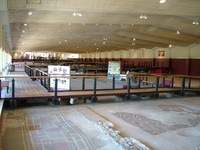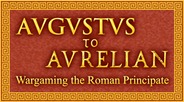Fishbourne Roman Palace

Okay, here we are again. I've more or less caught up with myself, having been 'out of commission' the best part of four weeks, with getting ready to decorate, decorating, clearing up after decorating, and going on holiday. On coming back, there were various jobs that needed attending to - we needed a new shoe-rack for the porch, my computer chair had imploded, etc. So some shopping and assembly of 'flat-packs' (if a chair can truly be said to be flat-packed) was called for. The new chair is quite comfortable - I'm sitting on it now.
So, let's hurriedly draw a veil over the DIY and decorating: I'm sure you don't want to hear about them, other than to gloat over my misfortune, and move on to the interesting stuff - my holiday.
Let's take things in order. First of all, the launch party for Harry Sidebottom's new book "Lion of the Sun". This was held in a bar in Woodstock, near Oxford. I was, frankly, right outside my comfort zone. I'm a typical geek in some ways - I don't really do small-talk, and I'm not keen on parties. Fortunately, there were quite a few people there who were obviously of the same frame of mind - standing around, alone, not quite knowing what to do, so I put my brave face on and talked to them. Had some good conversations about all sorts of stuff. So the party was actually quite enjoyable. And it was nice to see 'how the other half live'. Just one thing unsettled me slightly - Harry kept introducing me to people as his 'über-fan'. I can't quite decide whether to be pleased that he appreciates me, or outraged because he thinks I'm some sort of lunatic, frothing at the mouth.
Harry very kindly signed a copy of the book for me, and I started to read it straight away when we got back to our hotel. It is, of course, very good. It's the, now usual, mix of a great story intermingled with lots of period history and culture, the story cleverly constructed to take advantage of the little we know about the real Ballista (or Callistus, as he's referred to in some sources) and the events of that fascinating period. The plot of this book is rather more involved than the previous ones, and there is a fair bit of 'flitting around' from setting to setting, and person to person, which I found made following the plot a little more tricky. But it does all work out, in the end, and you can see how all the various threads come together. The copious notes and bibliography at the end is handy to have too - more than a few books worth seeking out. So it's a fun read, and educational too! The only downside to having read it so fast is that now I've got a whole year to wait until the next installment. :-(
The next day we moved on to the South Downs, and a little place called Ramsdean, which isn't far from Petersfield. We spent that day settling in, getting our bearings, doing a bit of food shopping, and finishing off "Lion of the Sun" whilst the others watched telly. The next day we did our only bits of 'ancient history' of the holiday - a visit to Butser Ancient Farm, closely followed by a visit to Fishbourne Roman Palace. Both were fascinating, and seeing the two on the same day really brought home the enormity of the changes the arrival of the Romans wrought on this land. The buildings at Butser are not small, or insubstantial - we often think of the ancient Britons as living in 'mud huts', but the large roundhouses really are quite large - 50' (15m) in diameter - and very solidly built. But the contrast between those, and Fishbourne's huge palace is remarkable. I've been to Fishbourne three times now, and I never cease to be amazed by the sheer scale of the structure, or its sophistication. It was about 400' (122m) square, and crammed with really fancy mosaics. I actually find it hard to believe that it was built for a 'client king' - it does seem far too grand for that - the Romans must have thought an awful lot of Cogidubnus, or whoever it was built for.
I'll post a few photos of the two sites in a day or two, and will probably return to the holiday theme too.
